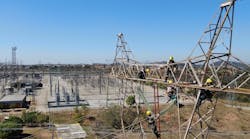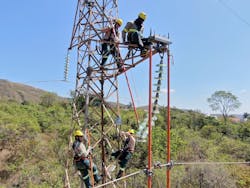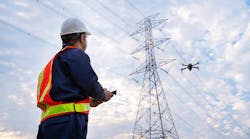Embracing the digital evolution is not just a trend, it's a strategic imperative for transmission line operators aiming to stay ahead in the dynamic energy landscape. This shift reduces operational costs, minimizes downtime, and enhances overall grid resilience, which creates direct benefits for society regarding energy quality and sustainability.
The multiple benefits of digitizing the power grids were sought after by CEMIG, an energy company in Brazil. To overcome the challenges, CEMIG partnered with Portuguese tech company, Enline Energy Solutions, for a sensorless Software as a Service (SaaS) solution, providing real-time data and insights without the need for physical sensors—a digital twin approach.
The partnership highlights the capability of the digital twin model to use real-time operational data, acquired directly from the Supervisory Control and Data Acquisition (SCADA) of CEMIG’s operating center. Digital Twin empowers CEMIG’s transmission line operators to optimize assets, reduce operational costs, and minimize carbon emissions. Eliminating the need for additional hardware and providing a remote, scalable, and environmentally friendly solution, has revolutionized the operational landscape for transmission lines.
The operations center runs in a highly safe environment, where access is strictly controlled in strict compliance with cybersecurity requirements. To ensure the safety of the data and the integrity of the system, an innovative solution was developed: a dedicated connection between the company’s Supervisory Control and Data Acquisition, or SCADA (operational network) and DATALAKE (corporative network).
This approach ensures connection with the DATALAKE is carried out securely, without exposing the operation center to cyber vulnerabilities. It is worth emphasizing that this solution was designed not to impose limitations, delays, or difficulties in data transfer, maintaining the efficiency and fluidity of the information flow, which is essential to the operation of the conceived solution.
Additionally, the solution complies with the Network Procedures of the National System Operator (ONS), specifically in line with the regulation No. RO-CB.BR.01, “Minimum cyber security control for the Regulated Cyber Environment,” which reinforces the robustness and reliability of the model and guarantees its scalability and applicability to other transmission agents of the National Interconnected System.
Applying the Technology
As the energy sector encounters more hurdles, monitoring solutions, including the digitalization of power assets, increase in popularity. Enline envisioned the growth of such issues and created a platform for energy monitoring, which includes a predictive dynamic line rating (DLR) feature. Currently, the digitalization of the grids is sought by multiple institutions, and monitoring features such as DLR are on their way to becoming mandatory in some countries, including the United States of America enforcing FERC 881.
Digitalizing transmission lines offers numerous benefits, including cloud-based or on-premises data security and privacy from reliable data collection. The “digital twin view” of a transmission line is a virtual model that mirrors the physical counterpart in real-time, integrating comprehensive data sets and analytical capabilities. Combined with artificial intelligence and machine learning, the digital twin allows for future-proof monitoring, as reliable forecasts are displayed. Thus, digital twin solutions enable CEMIG to continuous monitoring, proactive maintenance, and real-time analysis of operational efficiency, facilitating enhanced reliability and resilience of the transmission line infrastructure. Highly scalable, it ensures a reliable digital infrastructure for a skilled workforce for maintenance.
Overcoming One of the Digitalization Challenges
With the fast and ever-changing developments of digital transformation, one of the foremost challenges lies in upskilling field crews to operate effectively in an increasingly AI-driven landscape. While traditional mechanical expertise remains invaluable, the integration of advanced technologies like AI demands a new skill set and mindset. Ensuring that field crews are proficient in interpreting AI-generated data, predictive analytics, and digital twin technologies is critical.
To address this challenge, comprehensive training programs must be designed, blending mechanical fundamentals with digital literacy and AI application knowledge. Hands-on workshops, interactive simulations, and scenario-based learning can effectively bridge the gap, enabling technicians to grasp the intricacies of AI-driven systems. Enline’s web platform ensures an easy-to-use interface that serves as an initial approach to visualizing the virtual replica of an asset. It is important for field crews to understand the following aspects:
- Data pool and external data treatment
- 3D visualization
- Predictive alerts
The digital twin training begins when the crew understands that its primary purpose is to create a large array of data that was previously infeasible to gather in traditional ways. O&M crew must have a good understanding of what large data pools are and how to extract critical insights from them. In-house or outsourced statistics and data visualization training is required for employees to maximize their usage of digital twins. In comparison with other data visualization platforms, digital twins, especially if combined with 3D visualization, present a more intuitive, spontaneous, and rapid understanding of the data.
Advantages of Digital-based Sensors
A highly important topic for adapting to digital solutions is to be aware of the mathematical and physical properties of digital twins. Although a pure software solution may seem like a rough approximation of reality, international entities such as CIGRE, IEEE, EPRI, ASTM, and many more, endorse the modeling of every single type of asset. The result of years of continuous modeling is a 98% match of variable values over 94% of the entire asset. This means that a high-granularity digital twin can be more effective than the installation of a few physical sensors along a transmission line or any other type of energy-intensive asset. Digital technology, sensor-based applications now serve as a validation tool instead of the main solution, as sensors tend to have a limited life span and can go offline due to harsh weather conditions and loss of communication.
A Culture of Continuous Learning
Additionally, fostering a culture of continuous learning through access to online resources is critical. Specialized courses, and industry partnerships can keep field crews abreast of the latest technological trends and developments. A December Report by The U.S. National Science Foundation, underscores the “promise of digital twin technology.” By prioritizing tailored training initiatives and fostering a culture of continuous learning, the energy sector can successfully navigate the challenges of digitalization and leverage the full potential of digital twins.
Operating transmission lines comes with challenges that can impact the power grid's reliability, as aging infrastructure increases the risk of failures and outages while maintaining remote lines poses logistical hurdles. Upgrading the grids with new assets and renewable energy creates a planning issue due to the increase in complexity of the system.
Overcoming these issues requires proactive maintenance, strategic planning, and robust monitoring systems to bolster the resilience and efficiency of transmission line operations
By digitizing their grid CEMIG is maximizing their system reliability and sustainability, and also optimize their vegetation management program and landslides and asset failure forecasting.
Fabio Antunes is an electric engineer at CEMIG. He received his PhD in electric engineering from the UNIFEI (Universidade Federal de Itajubá) and has 16 years of experience in electric systems operations.
Leonardo Bonatto is a power systems electrical engineer at Enline Energy. He graduated from Universidade Federal do Paraná – UFPR with a degree in electrical engineering. Bonatto has specialized in distributed energy resources, digital twins, hybrid solar power plants, and powerinverters.




